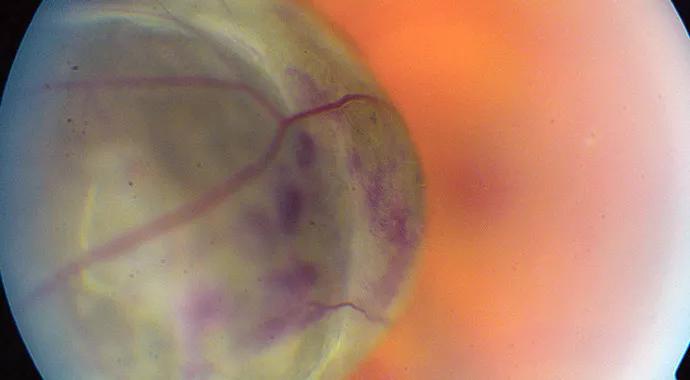New options being explored may one day improve outcomes

By Arun D. Singh, MD, Cleveland Clinic Cole Eye Institute ocular oncologist
Advertisement
Cleveland Clinic is a non-profit academic medical center. Advertising on our site helps support our mission. We do not endorse non-Cleveland Clinic products or services. Policy
Overall mortality in uveal melanoma is high due to metastatic disease that develops despite advances in its diagnosis and improvements in local tumor control. Several lines of evidence indicate that micrometastases are present in many patients with uveal melanoma at the time of ophthalmic diagnosis. In partnership with Pierre Triozzi, MD, of the Taussig Cancer Institute, we have explored new options to treating this challenging disease. An effective strategy to improve survival in uveal melanoma would be to identify patients with micrometastases and suppress those micrometastases before they progress to macrometastases. Chromosomal aberrations (monosomy-3 and others) and gene expression profiling of tumors are superior to clinical and histopathological factors in predicting metastasis.
Fine-needle aspiration biopsy of tumors at the time of local therapy (plaque radiation), tumor resection and enucleation are the methods applied to obtain material for molecular prognostication. The time from diagnosis of the primary tumor to discovery of metastasis can range from weeks to decades. Assessment of tumor tissue, however, does not indicate whether tumor cells have actually been shed or are forming metastasis, and whether adjuvant treatment is reducing micrometastasis.
The identification and validation of blood biomarkers may permit early detection of uveal melanoma metastasis and could potentially allow for adoption of effective strategies to suppress micrometastases before they progress, thereby improving prognosis. Cole Eye Institute is actively exploring the utility of immune regulation factors in the blood and other new blood biomarkers in an effort to better define prognosis and monitor disease progression in patients with uveal melanoma.
Advertisement
Detection of circulating melanoma cells is a convenient test that may be potentially useful for diagnosis, risk stratification, identification of metastasis and treatment monitoring in uveal melanoma. The results of polymerase chain reaction-based and immunomagnetic techniques tested to date are controversial and cannot be interpreted reliably.
A variety of blood constituents, ranging from melanoma-associated mRNA, vascular endothelial growth factor, hepatocyte growth factor, epidermal growth factor and insulin-like growth factor-1 (IGF-1) have been implicated in progression of uveal melanoma and are measurable in patient serum or in experimental models of uveal melanoma. For various biological and technical reasons, these biomarkers have not demonstrated to date the sensitivity, specificity and predictive values necessary to monitor metastasis in patients with uveal melanoma.
Beta2-microglobulin (B2M) is a component of the HLA class I molecule light chain. Like the HLA class I heavy chain, tumor B2M expression by immunohistochemistry has been associated with metastasis in uveal melanoma. Because it is noncovalently associated, B2M can circulate. We studied 76 patients, 47 treated by plaque brachytherapy and 29 treated by enucleation. Thirty-three (43 percent) of the tumors manifested monosomy-3. Most tumors were large, were located in the choroid and were of mixed cell type. Blood was drawn in patients without metastatic disease prior to fine-needle aspiration biopsy. Tumor chromosome 3 status was determined by fluorescence in situ hybridization. Levels of B2M, IGF-1 and insulin-like growth factor-binding protein-3 (IGFBP-3) were determined by enzyme-linked immunosorbent assays. Blood levels of IGF-1 and IGFBP-3 were not associated with tumor monosomy-3. In contrast, increases in blood B2M (p ≤ 0.02) were.
Advertisement
The independent association of increased blood level of B2M and tumor monosomy-3 status was confirmed in multivariable analysis. Measuring blood levels of B2M in patients with primary uveal melanoma may therefore have prognostic value and may help guide surveillance and adjuvant therapy recommendations.
For more information, contact Dr. Singh at ophthalmologyupdate@ccf.org.
Advertisement
Advertisement

First-of-its-kind research investigates the viability of standard screening to reduce the burden of late-stage cancer diagnoses

Global R&D efforts expanding first-line and relapse therapy options for patients

Study demonstrates ability to reduce patients’ reliance on phlebotomies to stabilize hematocrit levels

A case study on the value of access to novel therapies through clinical trials

Findings highlight an association between obesity and an increased incidence of moderate-severe disease

Cleveland Clinic Cancer Institute takes multi-faceted approach to increasing clinical trial access 23456

Key learnings from DESTINY trials

Overall survival in patients treated since 2008 is nearly 20% higher than in earlier patients